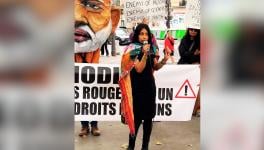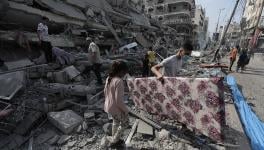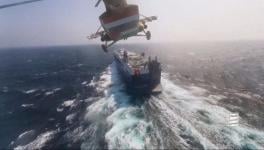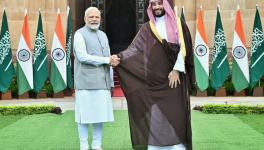Nepal Earthquake: How Prepared is the Region for Such Disasters?
The Nepal earthquake has officially killed more than 7,000, injured many more and devastated parts of Nepal. How ready are we in South Asia for facing such disasters? Newsclick speaks with D. Raghunandan, President of All India Peoples science Network on this issue. The discussion also covered the role of Indian teams, the criticism of its media and and the longer term issue of rehabilitation. Raghu also spoke of the weakness of the Nepalese government, particularly of its Army, to co-ordinate the relief efforts.
Newsclick asked Raghu regrading earthquake prediction and some recent pronouncements of more such mega quakes. Raghu clarified that earthquake predictions are not useful right now, but there are hopes that it might get better in the future. What we need is therefore better standards of construction, better building codes and better preparedness to face mega quakes, particularly in the Himalayan region.
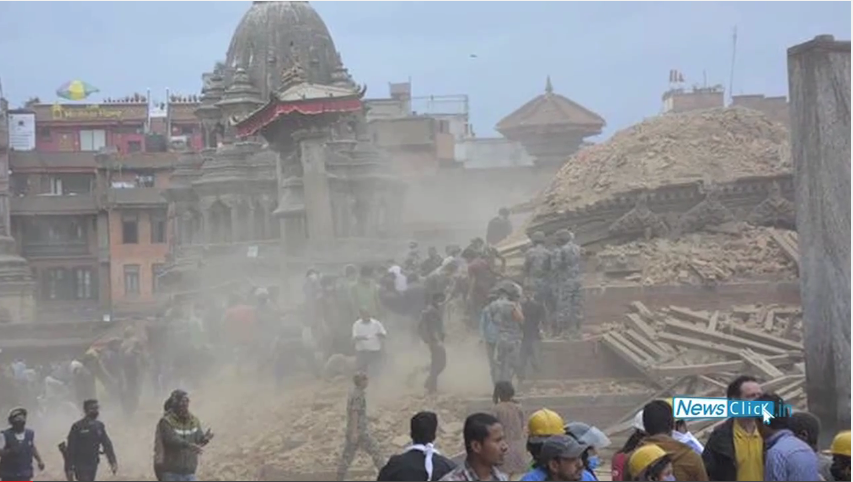
Prabir Purkayastha (PP): Hello and welcome to Newsclick. The devastation of the earthquake in Nepal is visible to everybody officially more than 7000 killed probably, the figures are much higher. We are going to discuss with D. Raghunandan from the All India Peoples Science Network what are the implications of the earthquake, what's the disaster relief that has been provided, what are the steps we can take all of the South Asian countries we are bordering Himalayas. Raghu, what do you think the Nepal earthquake shows the South Asian countries are really not ready for disaster relief, disaster management. We have seen this earlier in Kashmir on floods on both sides of the Indian and Pakistani border. Do you think it is the repetition of the same.
D. Raghunandan (DR): Absolutely. Particularly, there are three aspects which we need to talk about separately. The first is disaster preparedness which I think is the weakest and which should have been the most important. The second part is disaster response immediately in terms of relief and rescue. We are getting slightly better than that at least in India and therefore, what we saw in Nepal with India coming to their aid fairly quickly, we were actually able to contribute something of significance to Nepal and the third is the post disaster rehabilitation efforts which again I believe is weak link. So the only area where I think India in particular has improved somewhat has been in cyclone related preparedness, where we have had some improvement and a little better preparedness in terms of being able to respond through rescue teams. On these two fronts, India has made some improvement but I think the rest of South Asia has not and I think even in India with the exception of the cyclone preparedness, if an earthquake struck in Uttarakhand tomorrow, I think we will be more or less in the same position as in Nepal.
PP :Coming to Nepal and it's really what you are saying is the fact that was relief measures, some measures we were able to take. But, the Nepal government is criticized very strongly that they did not coordinate the relief work and the Indian relief work is of course coming to criticism because of privileging the media and making it more of a PR show rather than really getting into the disaster relief. So do you think that this criticisms are valid.
DR: Partly yes. In the sense that India was effective in being able to provide helicopters. Especially, helicopters with lift capabilities. So you are able to go into areas, pull up damaged structures which will allow ground teams to get into rescue people, you are able to land helicopters in areas where nobody had reached so that some preliminary system could be given in loading in injured people into the helicopters and bringing them into the nearest hospital. To that extent we were able to provide some rescue infrastructure and capability. But, it also showed I think the weaknesses in our envisioning what it involves. For example, none of the helicopters which went had first aid equipments or medical teams on board. So you had a winch, you are able to load people into the helicopters but if something happened to somebody on the way, you could not administer drip, you didn't have doctors teams or para medics on board which could give them important response and and triage inputs while transporting them to hospital. So we just used the helicopters as transporters and not just part of a medical link that you need to provide. As far as the media is concerned, I think definitely, the Modi government used the disaster response as a PR effort with respect to Nepal and particularly with reference to China and wanted to do a one oneupmanship in Nepal saying look we have been able to provide more assistance than China which is not necessarily true, but our media certainly did not highlight the role played by Chinese rescue teams which was actually quite significant.
PP: Instead of providing together cooperatively assistance, it became oneupmanship. How do you …
DR: Partly yes, But partly I would also I would say the Nepal government ultimately, it is the host government which has to play the role in coordinating various rescue and relief efforts and I am afraid this time the Nepal government showed itself to be completely accede on this. Various rescue teams going in and doing things on their own. There was little coordination role being played by the Nepalese government. Partly one could say we can not blame them because after all they themselves were most affected. Kathmandu being the worst hit. So I am sure that the government servant, civil servants was deeply affected by the earthquake themselves and were not in a position to respond. But I think the most disappointing feature if you ask me is the lack of the response on the part of the Nepalese military which has otherwise been playing such a major role in Nepal. But I think, over the year with the extent of infighting within Nepal, the battle between the Maoists and the army we have seen a decimation of capability of the Nepalese military which I think was quite revealing during this episode.
PP: The other argument which have been talked about is the fact that the Nepal is still very centralized. It is earlier, the King, so everything was very Kathmandu centric. There is no federal structures in place and therefore, also the inability of the far flung regions to provide any kind of support, help and so on to the affected villages. Do you think this was also be the fact.
DR: During the long years of the Maoist insurgency in Nepal, you saw a decentralized military presence of the Maoists in the country side. But I think once that insurgency reached it's peak and resulted in their entering into governance, one saw even that decentralization disappeared and that is what I was pointing to when I was saying that this is a visible lack of response, the Maoists had a greater presence in their countryside militarily. That presence was not visible at all.
PP: Coming back to Kathmandu itself, the old Newari areas which are really the heritage sites of Kathmandu and so on, they have all fallen to the ground and destroyed. And the part of it is also because this heritage sites were really not showed up, not looked after and people didn't anticipate that there was a possibility of earthquake?
DR: Absolutely. Unfortunately, I think as I was saying in the beginning, this has been the weakest part of the disaster preparedness effort throughout this South Asian region and India which is the strongest country has shown the extent of lack of preparedness that we know that it exists, why should we be surprised that the Nepal was not better prepared. There has been no retrofitting of structures whether they are residential or heritage structures. I think this is the area where our governments all over South Asia have shown to be completely ineffective, not just in implementation but even in thinking and planning in terms of preparedness. Like I said, we had some evidence of preparedness when it comes to cyclones in building shelters for example so you can evacuate people and put them in there. We have got early warning systems. Now, you can't have early warning systems for earthquakes. You can't evacuate people because of that. So what you can do is to do preparedness in terms of shoring up buildings and infrastructure in these areas. That is what really you need to do.
PP: Other issue that I wanted to talk about is that you know there is a case, a famous case as you know in earthquake prediction that caused some of the Italian earthquake scientists to be, a geologists who was actually arrested and tried. Do you think that the prediction of the earthquake is remotely possible with the knowledge that we have?
DR: Not with the knowledge that we have today. But there are signs that we would be able through projections to be able to at least have not forecasts in terms of next month or next year but to say may be next three years, within the next three years one can expect because these are basically, earthquake prediction techniques are based on probability forecasting knowing that there is energy being built up and therefore, the more the time elapses before an earthquake happens, the greater becomes the probability of an earthquake occurring. That combined with slightly more accurate monitoring of tremors and tectonic activities below combined are likely to give you better predictive ability current trend seem to suggest that you may have better predictive ability may be twenty five to thirty years down the road. That's the earliest that we are.
PP: At the moment, our predictions are five years to hundred years. That doesn't really help.
DR: Like we know, in Nepal for example, everyone was saying, this is the earthquake we were waiting for. But you are waiting for it, it could come tomorrow, it could come next year, it could come in five years, that's not prediction. There is nothing you can do and therefore, that is why I say, since you know something is going to come and we are sitting on zone 4 or zone 5 you should be taking precautions now because we don't know when it is going to happen.
PP: Last question, that we don't want to sound trying to raise a scare, but the earthquake waiting to happen there are predictions now, there are two more zones, the similar energies are building up. It's really again the same issue the India plates going under the Eurasean plate and these zones are long zones therefore with lots of energy, therefore, a possibility of equally severe and in once case, somebody has said more severe earthquake. So do you think the earthquake that we all waited to happen take place again?
DR: Very difficult to say of course, the only possible relieving factor could be that since you had such a large earthquake now, may be a substantial part of that pent up energy has been released. But since there are two other fault lines, where there is still pent up energy, may be that is waiting to be released as well. One can only hope that it is not too close to today but I believe that what one needs to be do not just in Nepal but in India in the Himlayas, in Northern India in general that we need to be anticipating the possibility of an earthquake happening anytime and we need to take precautionary measures in terms of building structures or building chords and some retrofitting of existing buildings as well.
PP: Thank you very much Raghu to discuss these kind of issues and other important issues on the question of disasters, ecological issues with you as the time rise. Thank you very much.
Get the latest reports & analysis with people's perspective on Protests, movements & deep analytical videos, discussions of the current affairs in your Telegram app. Subscribe to NewsClick's Telegram channel & get Real-Time updates on stories, as they get published on our website.










